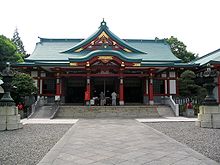Hie shrine
The Hie Shrine ( Japanese 日 枝 神社 , Hie-jinja ) is a Shinto shrine in the Nagata-chō district of the Chiyoda district . The highest kami of the shrine is Ōyamakui no kami ( 大 山 咋 神 ), deity of the mountain Hiei-zan and generally also called Hie no kami or Sannō Gongen . Another kami is izanami . The Hie Shrine is one of over 3,000 branch shrines of the Hiyoshi Taisha (originally also Hie Shrine) in Ōtsu , Shiga Prefecture .
history
The Hie shrine is said to have been moved in 1478 by Ōta Dōkan of Kawagoe as a protective shrine to the newly built Edo Castle . However, there is evidence that this shrine existed in the area as early as 1362. When Tokugawa Ieyasu took over Edo in 1590, the shrine initially remained in place, but the second shogun, Tokugawa Hidetada , moved it outside on a hill opposite the Hazomon Gate in 1613. The shrine burned down in the Great Meireki Fire in 1657 and was rebuilt in 1659 by Tokugawa Ietsuna at the current location.
The attachment
The shrine, located on a hill above the former inner moat, is accessible from this side through a torii in a shape that is typical for this shrine and is therefore called Sannō-Torii. The steep staircase leading up to it is called "Men's Path to Sannō" (山 王 男 坂, Sannō Otoko-zaka), the curved path to the right of it is called "Sannō Women's Path" (山 王 女 坂, Sannō Otoko-zaka). Above, in front of the actual shrine area, on the left is the covered water basin (手 水 舎, temizusha), which is used to cleanse the mouth and hand. The interior is entered through the "God Gate" (神 門, Shinmon). On the opposite side is the prayer hall (haiden, 拝 殿) and behind it the worship hall (honden, 本 殿).
On November 8, 1868, the Hie shrine was appointed by the Meiji - tennō to one of the "Ten Shrines of Tokyo" ( Tōkyō-jissha ).
The shrine was destroyed a second time by bombing during World War II and rebuilt in 1967. The cost of over 150 million yen was largely borne by parishioners and believers.
The Hie Shrine directed every other year alternately to Kanda Matsuri of early to mid-June, the Sannō- Matsuri from. Until 1885 it was one of the three largest festivals in Tokyo, after which the installation of electrical cables prevented the 45 large floats from getting through. Currently, the festive procession on June 15 includes only three holy sedan chairs that traditionally move into the imperial palace, where the high priest prays for peace for the emperor and his family.
literature
- Leaflet of the shrine
- Tōkyō-to rekishi kyōiku kenkyōkai (Ed.): Tōkyō-to no rekishi sanpō (jo). Yamakawa Shuppan, 2001, ISBN 978-4-634-29130-0 , pp. 74-75.
Web links
- Official website - Japanese and English
- Photographs of the shrine of I. Hatada
Coordinates: 35 ° 40 ′ 28.9 " N , 139 ° 44 ′ 22.54" E


